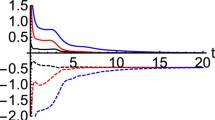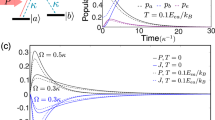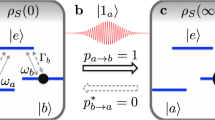Abstract
For the Blume–Emery–Griffiths (BEG) model with a positive biquadratic coupling and without the ferromagnetic coupling, the microcanonical ensemble predicts that the entropy of this model is a multivalued and non-concave function of the energy, leading to an absolute zero temperature at its highest energy level. Via increasing the energy of a BEG system, its temperature can get close to absolute zero in local microcanonical dynamics. By building up a weak coupling between two identical BEG subsystems with their energies equal to half of the highest value of the energy of this model, one subsystem can absorb energy from another and both of them evolve to the absolute zero of temperature.
Graphic abstract





Similar content being viewed by others
Data Availibility Statement
This manuscript has no associated data or the data will not be deposited. [Authors’ comment: The data reported in the paper are available from the corresponding author on reasonable request.]
References
E.D. Eastman, The third law of thermodynamics. Chem. Rev. 18(2), 257–275 (1936)
M. Blume, V.J. Emery, R.B. Griffiths, Phys. Rev. A 4, 1071 (1971)
F.C. Alcaraz, J.R. Drugowich de Felício, R. Köberle, J.F. Stilck, Phys. Rev. B 32, 7469 (1985)
J. Barré, D. Mukamel, S. Ruffo, Phys. Rev. Lett. 87, 030601 (2001)
R.B. Frigori, L.G. Rizzi, N.A. Alves, Eur. Phys. J. B 75, 311 (2010)
V.V. Hovhannisyan, N.S. Ananikian, A. Campa, S. Ruffo, Phys. Rev. E 96, 062103 (2017)
V.V. Prasad, A. Campa, D. Mukamel, S. Ruffo, Phys. Rev. E 100, 052135 (2019)
T. Dauxois, S. Ruffo, M. Wilkens, E. Arimondo, Dynamics and Thermodynamics of Systems with Long-Range Interactions (Springer, New York, 2002)
A. Campa, T. Dauxois, D. Fanelli, S. Ruffo, Physics of Long-Range Interacting Systems (Oxford University Press, Oxford, 2014)
D. Mukamel, S. Ruffo, N. Schreiber, Phys. Rev. Lett. 95, 240604 (2005)
J.-X. Hou, X.-C. Yu, J.-M. Hou, Int. J. Theor. Phys. 55, 3923–3926 (2016)
J.-X. Hou, X.-C. Yu, Mod. Phys. Lett. B 32, 1850053 (2018)
Z.-Y. Yang, J.-X. Hou, Mod. Phys. Lett. B 33, 1950072 (2019)
Z.-Y. Yang, J.-X. Hou, Eur. Phys. J. B 92, 170 (2019)
J.-X. Hou, Phys. Rev. E 99, 052114 (2019)
J.-X. Hou, Eur. Phys. J. B 93, 82 (2020)
Z.-Y. Yang, J.-X. Hou, Phys. Rev. E 101, 052106 (2020)
Z.-X. Li, Y.-C. Yao, S. Zhang, J.-X. Hou, Mod. Phys. Lett. B 34, 2050318 (2020)
J.-X. Hou, Eur. Phys. J. B 94, 6 (2021)
Y.-C. Yao, J.-X. Hou, Int. J. Theor. Phys. 60, 968–975 (2021)
S.-Y. Jiao, J.-X. Hou, Mod. Phys. Lett. B 35, 2150095 (2021)
M. Kac, G.E. Uhlenbeck, P.C. Hemmer, J. Math. Phys. 4, 216–228 (1963)
P. Gaspard, J. Stat. Mech. 2012, P08021 (2012)
S. Friedli, Y. Velenik, Statistical Mechanics of Lattice Systems: A Concrete Mathematical Introduction (Cambridge University Press, Cambridge, 2017)
A. Deger, C. Flindt, Phys. Rev. Res. 2, 033009 (2020)
G.C. Lau, R.S. Freitas, B.G. Ueland, B.D. Muegge, E.L. Duncan, P. Schiffer, R.J. Cava, Nat. Phys. 2, 249 (2006)
H.D. Zhou, C.R. Wiebe, J.A. Janik, L. Balicas, Y.J. Yo, Y. Qiu, J.R.D. Copley, J.S. Gardner, Phys. Rev. Lett. 101, 227204 (2008)
G.-W. Chern, M.J. Morrison, C. Nisoli, Phys. Rev. Lett. 111, 177201 (2013)
A. Ramírez-Hernández, H. Larralde, F. Leyvraz, Phys. Rev. Lett. 100, 120601 (2008)
A. Ramírez-Hernández, H. Larralde, F. Leyvraz, Phys. Rev. E 78, 061133 (2008)
M. Creutz, Phys. Rev. Lett. 50, 1411 (1983)
W. Nernst, Nachr. Kgl. Ges. Wiss. Goett. 1, 1–40 (1906)
L. Masanes, J. Oppenheim, Nat. Commun. 8, 14538 (2017)
Author information
Authors and Affiliations
Contributions
J-XH provided the idea, made all the computations and wrote the manuscript.
Corresponding author
Rights and permissions
About this article
Cite this article
Hou, JX. Approaching the absolute zero of temperature via absorbing energy. Eur. Phys. J. B 94, 151 (2021). https://doi.org/10.1140/epjb/s10051-021-00144-5
Received:
Accepted:
Published:
DOI: https://doi.org/10.1140/epjb/s10051-021-00144-5




